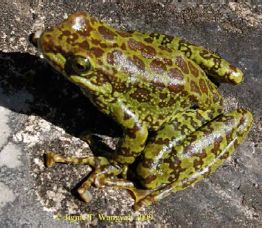Atympanophrys is a genus of frogs in the family Megophryidae. They range from central China south to northern Vietnam. They are commonly known as hidden-tympanum horned toads.

The Asiatic toad or Chusan Island toad is a species of toad endemic to East Asia. The species was previously classified as Bufo bufo gargarizans, a subspecies of the common toad.
The Duke of Bedford's vole is a species of rodent in the family Cricetidae. It is found only in mountainous parts of central China. It is a rare species and the International Union for Conservation of Nature has assessed its conservation status as being "vulnerable".

The Wenxian knobby newt or Wenxian knobby salamander is a species of salamander in the family Salamandridae. It is endemic to central China. Its type locality is Wen County in Gansu, or in Chinese: 文县; pinyin: Wénxiàn, hence the name.
The Chiala mountain salamander is a species of salamander in the family Hynobiidae endemic to China and known from northwestern Sichuan, northeastern Tibet, and southeastern Gansu. Its validity as a species distinct from Batrachuperus tibetanus has been controversial. It is named after Karl Patterson Schmidt, American herpetologist.
The alpine stream salamander is a species of salamander in the family Hynobiidae endemic to central China. Its natural habitats are rivers and freshwater springs. It is threatened by habitat loss.
Oreolalax nanjiangensis is a species of amphibian in the family Megophryidae. It is endemic to China. It is known from the area of the type locality of Mount Guangwu (光雾山), Nanjiang County, northern Sichuan, as well as adjacent southern Gansu and southwestern Shaanxi. Its natural habitats are temperate forests and rivers. It is threatened by habitat loss associated with tourism.
Oreolalax pingii is a species of amphibian in the family Megophryidae. It is endemic to south-western China where it is restricted to the Daliang and Hengduan Mountains in Sichuan and Yunnan. Its natural habitats are subtropical moist montane forests, moist shrubland, and rivers. It is threatened by habitat loss.
Oreolalax schmidti is a species of amphibian in the family Megophryidae. It is endemic to China where it can be found in the Hengduan Mountains in western Sichuan and northern Yunnan provinces. Its natural habitats are temperate forests, subtropical moist shrubland, rivers, swamps, and freshwater marshes. It is threatened by habitat loss. It is named after Karl Patterson Schmidt, American herpetologist.
Scutiger muliensis is a species of amphibian in the family Megophryidae. It is endemic to Sichuan, China, where it is only known from the area of its type locality in Muli county, altitude 3,050–3,400 m (10,010–11,150 ft) asl. Its common name is Muli cat-eyed toad.
The Shaping horned toad is a species of frog in the family Megophryidae. It is endemic to China and known only from Sichuan and Yunnan provinces. Its natural habitats are subtropical or tropical moist montane forests, subtropical or tropical high-altitude shrubland, and rivers. It is threatened by habitat loss.
Atympanophrys wawuensis, commonly known as the Wawu horned toad, is a species of frog in the family Megophryidae. It is endemic to China. It is only known from the type locality, Mount Wawu in Hongya County, Sichuan, which is located to the northwest of Mount Emei. Its natural habitats are temperate forests, rivers, and intermittent rivers. It is threatened by habitat loss.

Amolops chunganensis is a species of frog in the family Ranidae. Its type locality, Kuatun village in Wuyishan, Fujian. It is endemic to central, southern and eastern China where it has a wide but scattered distribution ; records from Vietnam probably refer to Amolops mengyangensis.

Amolops mantzorum, commonly known as the Sichuan torrent frog or Kangting sucker frog, is a species of frog in the family Ranidae. It is found in Gansu, Sichuan, and Yunnan Provinces of China. It has recently been reported also from Bhutan.

Nanorana pleskei is a species of frog in the family Dicroglossidae. Until recently it has been only known from southwestern/central western China from elevations between 3,300–4,500 m (10,800–14,800 ft), but there is now one record also from Bhutan. Notice, however, that earlier records outside China have turned out to be misidentifications.
Odorrana hejiangensis is a species of frog in the family Ranidae that is endemic to China. It is found in the Yangtze River Valley of southern Chongqing and northern Guizhou, with an isolated record in western Guangxi. Its name refers to the type locality, Hejiang County in northern Sichuan. Its natural habitats are shaded hill streams and the surrounding riparian forests. Its status is insufficiently known.
Odorrana kuangwuensis is a species of frog in the family Ranidae that is endemic to China. It is found in northeastern Sichuan and northwestern Hubei. Its name refers to the type locality, Mount Guangwu in Nanjiang County, northern Sichuan.
The plateau brown frog or plateau wood frog is a species of frog in the family Ranidae, endemic to the plateau region of western China. It was previously included in Rana chensinensis but it now considered a valid species. It is a common frog in suitable habitats that include alpine meadows, marshland and grassland. It hibernates in streams. It is not considered threatened by the IUCN.
The Sichuan frog is a species of frog in the family Ranidae found in China and possibly Myanmar. Its natural habitats are temperate shrubland, temperate grassland, rivers, intermittent rivers, swamps, freshwater marshes, and intermittent freshwater marshes.
Zhangixalus chenfui, also known as Chinese whipping frog or Chenfu's treefrog, is a species of frog in the family Rhacophoridae endemic to China where it is found in Sichuan, Guizhou, Hubei, and Fujian provinces. Its natural habitats are temperate forests, subtropical moist lowland forests, subtropical moist montane forests, subtropical moist shrubland, freshwater marshes, rural gardens, ponds, and irrigated land. It is not considered a threatened species by the IUCN.





